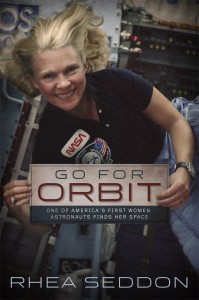In 1978 NASA selected thirty-five new Astronauts for the Space Shuttle. There were six female astronauts in the class: Sally Ride, Judy Resnik, Anna Fisher, Kathy Sullivan, Shannon Lucid, and me.
I was the smallest.
We had to figure out how to fit into a world populated almost entirely by men, most of whom were engineers and pilots. We women understood that we would have to act as a team on some things but that we’d be in competition for others, like Shuttle flights. We would have to help spaceflight designers integrate “the fairer sex” into the machinery that would launch us into space.
A strange mix, we first female astronauts: we ran the gamut from defiantly single to a mother of three. There were two medical doctors and four Ph.D.’s: a biochemist, a geologist, an astrophysicist, and an engineer. We ranged from staunch feminists to a Southern lady. Some were gregarious, others brilliant, and a few even hated being in the public eye. We were all eager to be a part of what was viewed by some as one of the greatest accomplishments of our generation. Alterations in the space vehicles had to be made. Some were of great importance and others a little silly. Here are examples of each.
Early in our training, NASA asked us to help develop a way for women to urinate while strapped into our seats for launch and in the spacesuit for spacewalks. The men had a condom that connected to a tube that emptied into a bag strapped to their leg. To make a device similar to what the men used, unworkable designs were proposed. Despite many attempts, no one could come up with something women could wear close to their bodies that caught all the urine and corralled it into a bag. Luckily, adult diapers were in early commercial development and panty girdles—though abandoned thanks to the Women’s Liberation movement—were of recent memory. The two were combined into an absorbent trunk that worked well, if you could talk yourself into wetting your pants. Problem solved.
This is the patch designed to commemorate the selection of the 1978 group of astronauts who would fly on the Space Shuttle.
A meeting with the women and the male engineers was convened to address the less serious dilemma. Did the women want to wear makeup in space? Anything that was flown on the Shuttle, makeup included, had to be tested for flammability and “off gassing,” that is to make sure it didn’t pollute the air of the closed-up vehicle. There were loud guffaws by a few of the women as though that was ridiculous because they never wore makeup. However, there was one fair blonde who pointed out that the pictures taken of us in space would follow us for the rest of our lives, and she—for one—didn’t want to disappear into the background. As a compromise, the equipment engineers worked with us to put together a makeup kit that could be requested if we wanted to take it on our flight. Of note, several of the women who had laughed at the thought decided to take it along. Many other questions large and small surfaced as we began flying, and we learned to work together to address them all.
– Rhea


